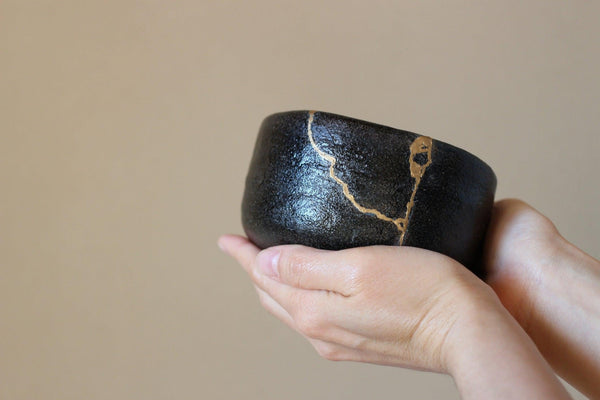
Jump to:
Kintsugi, simply put, is the Japanese art of repairing broken pottery by joining the broken pieces with lacquer and covering the lacquered cracks with gold to create a special object of its own. In fact, the word itself comes from the Japanese word Kin (金) meaning gold, and tsugi (継ぎ) meaning “to join”. In many aspects of life, there is, at least ideally, a quest for perfection. The philosophy of Kintsugi, however, is that of discovering beauty in imperfection.
In this article, we shall look at the meaning of Kintsugi, the history of Kintsugi and its association with the tea ceremony, and the materials and techniques used to create Kintsugi. We shall go on to look at whether it has influenced contemporary art and look at famous Kintsugi artists, rounding off by checking out what you might need if you want to try doing Kintsugi yourself.
What Is The Meaning Of Kintsugi?
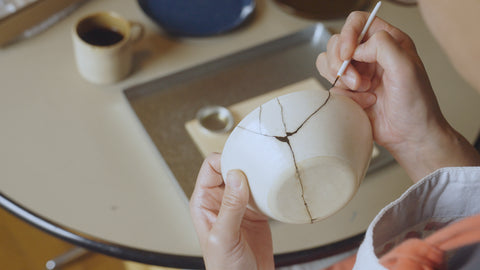
On a simple practical level, Kintsugi allows us to use items for longer. Obviously, performing Kintsugi on a cheap piece of crockery that we have dropped while washing up would not be cost-effective, as the cost of restoration far outweighs what buying a replacement would be, but long-cherished family heirlooms and items of a particularly sentimental value can be given a new lease of life.
When the object is repaired with lacquer and covered with gold, this creates a new pattern and fits in with the concept of rebirth and renewal. The original object remains, but it has evolved and become stronger.
As mentioned at the start of this post, Kintsugi encompasses the concept of finding beauty in perfection, and this fits in with the Japanese philosophy of Wabi-Sabi. Many people see a metaphor for human life in Kintsugi, with the cracks in the pottery symbolizing physical injuries or problems encountered in the course of human life. The restored Kintsugi work tells the history of the object and does not hide its imperfections. In a similar way, as humans, our faults in the past are part of the journey of our lives, and we should embrace them rather than attempt to conceal them.
The Origins Of Kintsugi
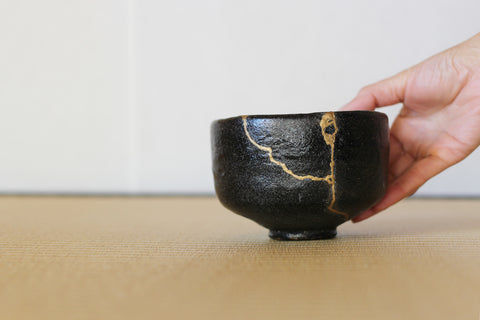
Whereas the use of lacquer as an adhesive for repairing objects has been used in Japan for the best part of a thousand years, it is considered that the origins of Kintsugi are more recent (although, admittedly, still quite old), dating back to the Muromachi period (approximately 1336 1573).
Its development is closely linked to the renewed interest in Zen philosophy and the development of the tea ceremony at that time, and, in particular, to a type of tea ceremony called Wabicha, in which waste is minimized to the utmost. This is a predominant theme in Buddhist teachings and deeply rooted in Japanese culture as a whole.
The Kintsugi technique was born as a result of the popularity of the tea ceremony culture. Even when used with care, tea utensils can become cracked or chipped. The idea of repairing such vessels and using them with care was the basis of Kintsugi.
Materials Used In Kintsugi
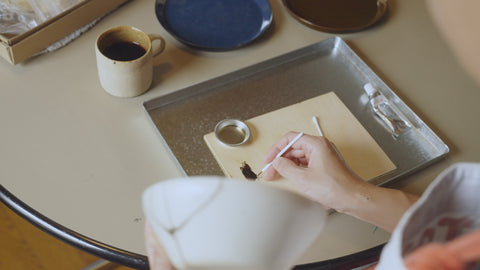
Traditional Kintsugi places a lot of emphasis on using only natural materials so that eventually they will naturally decompose back into nature. The lacquer used is the natural resin that comes from the sap of the Urushi tree. Retrieving just one cup of lacquer from the tree requires cutting down the tree. Kintsugi artists frequently talk of the lacquer as being a symbol of the “blood” of the tree, and the fact that the tree effectively gives its life to provide the lacquer is a reminder to us to truly value the Kintsugi work. The lacquer itself takes a long time to harden, which fits in with the philosophy of being prepared to wait for good things. This is used with powdered gold to create the final the finished product.
Modern Kintsugi places more focus on convenience and saving time, and so use synthetic glues. A major advantage of classic over modern Kintsugi is that the natural lacquer is “food safe” so it is possible to serve food in repaired bowls, and the like, after restoration, unlike modern Kintsugi restored objects, which can only be used for ornamentation.
Different Kintsugi Methods
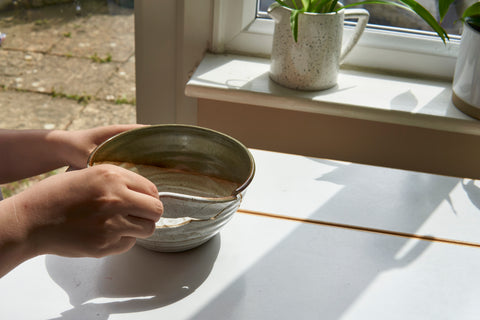
As previously described, we can distinguish between traditional and classic methods of Kintsugi. Traditional Kintsugi uses only lacquer, flour and water as its binding agent. This should be handled with care, as some people may be allergic to the lacquer. For this reason, it is recommended that you handle this with gloves unless you are sure that you are not allergic. It also takes two weeks to cure and is very particular about the temperature used. As mentioned above, its advantage is that the finished article can be used to contain food.
The same cannot be said for the synthetic lacquer using epoxy resin and mica powder. Though convenient and less allergenic, it is not “food safe” and its scope of use is limited to ornaments.
A halfway house between the two is “cashew lacquer”. Cashew lacquer, compared to traditional Sumac lacquer takes less time to cure, and is non-toxic, so can be used for items containing food.
Influence On Contemporary Art

Although the practice of Kintsugi itself has attracted a lot of attention in recent years, aspects of this ancient technique. Many contemporary artists and designers have incorporated the techniques, aesthetics and philosophy of Kintsugi into their work, using it to explore the concepts of loss, synthesis and improvement through destruction, repair and rebirth.
In the world of architecture, the Xchange apartments, developed by TANK, are characterized by their meticulous attention to detail. Traditional mortar is used, and the golden cracks, reminiscent of Kintsugi pottery, bring artistic life to the floors, thus embodying the spirit of Kintsugi art in the expression given to the living rooms. By bridging the cracks with gold epoxy resin, it transforms something originally considered imperfect into a thing of beauty.
Karen LaMonte, an American contemporary artist, is known for her large-scale sculptures of women’s clothing worn by invisible human figures. LaMonte used Kintsugi methods to repair ceramic sculptures, damaged as the result of a kiln explosion using gold, thus demonstrating the ability of art to transform something potentially broken into a thing of beauty.
Prominent Kintsugi Artists
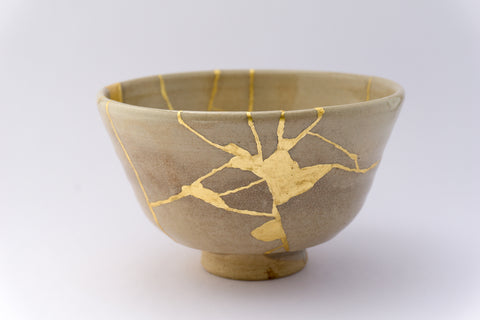
There is a wealth of prominent artists working with Kintsugi techniques for you to explore, and a few examples are given below to get you started.
Taku Nakano
This unique ceramic artist has a studio in Omotesando in Tokyo, and unlike many famous artists, is not from a potter’s family, but, rather he was inspired by pottery he saw in Shizuoka, and decided to quit his office job and teach himself pottery from the age of 36. He often incorporates the motifs of the universe and planets into his creations.
Yukako Tanaka
Yukako Tanaka, a Kintsugi master, developed a form of modern Kintsugi that uses a hybrid chemical solvent called “new Urushi”, rather than the traditional form of lacquer. The solvent follows the tradition of using materials that are kind to the body and do not cause rashes. The gold powder used is non-metallic, so is also safe for people with metal allergies to use.
Tomomi Kamoshita
Tomomi Kamoshita is a Japanese ceramist who had been interested in Kintsugi, but suffering from a lacquer allergy had been unable to explore the field. After discovering a synthetic lacquer that she could use, she has since become famous in the field for creating objects through Kintsugi using items discovered while walking on the beach.
D.I.Y Kintsugi?
Kintsugi is a traditional art developed over centuries requiring a high degree of skill to achieve striking works of art. However, if you are interested in trying out this artistic form and repairing some of your cherished ceramic items that have gotten broken, there are kits available to get you started.
The Tsugu company (https://tsugu-tsugu.shop-kintsugi.com/collections/kintsugi-kits) offers kits online that provide you with all you need to get started. The comprehensive “Traditional Kit” will set you back close to two hundred dollars, but includes all the necessary materials, including raw urushi lacquer and gold/silver powder, as well as utensils such as brushes and spatulas, as well as an instruction manual. They also have a starter kit for those on a tighter budget and offer Kintsugi workshops in Tokyo.
Finding Beauty In Imperfection With Kintsugi
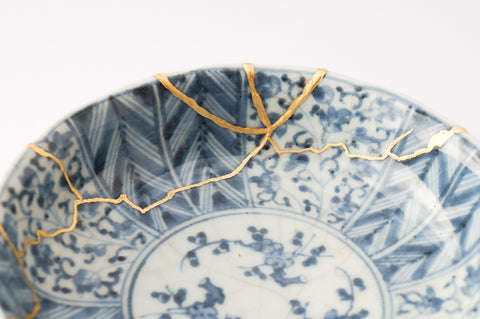
As described in this post, Kintsugi is one of the main types of Japanese pottery styles (check out some others in this article). Although developed as a way of mending broken ceramics, has a much more significant meaning in Japanese culture. Embracing the concept of Wabi-Sabi, or finding beauty in imperfection, it not only promotes the traditional Buddhist concept of avoiding waste but also acts as a metaphor for human life, as a journey that despite taking wrong turns can end in completion.
If you have the resources, you can pay a Kintsugi master to fix your cherished article in a highly ornate way, but for those on a smaller budget, it is also possible to buy kits and do it yourself!
Have you tried Kintsugi pottery yet? Let us know in the comments.


0 comments